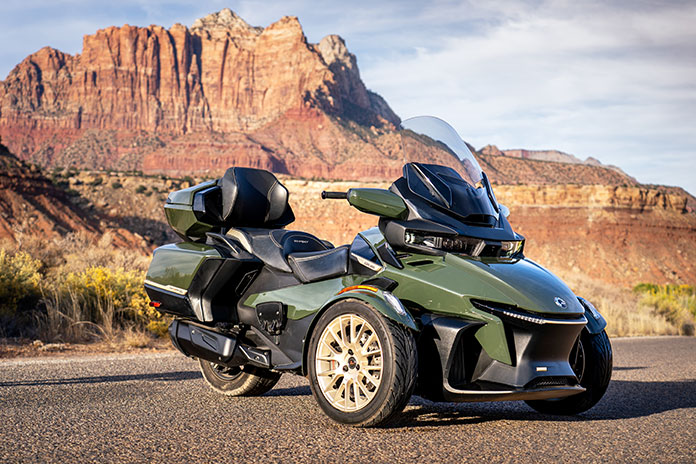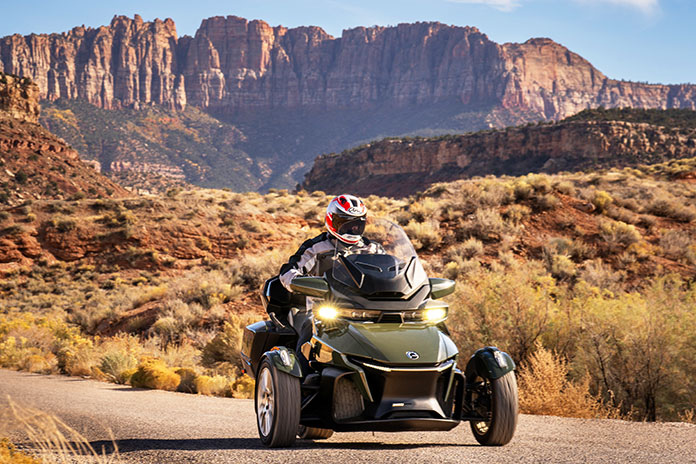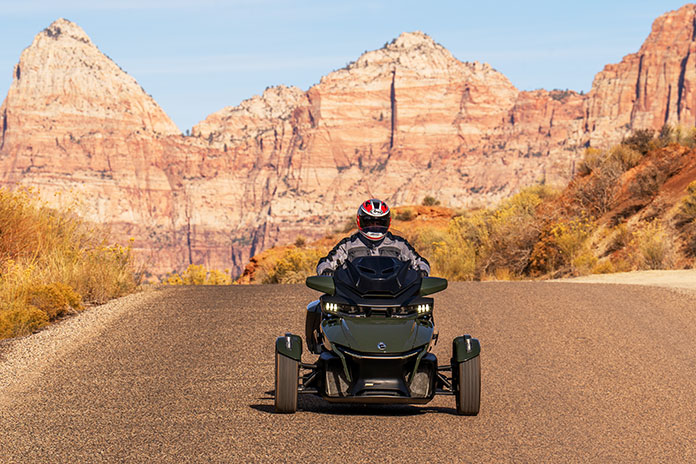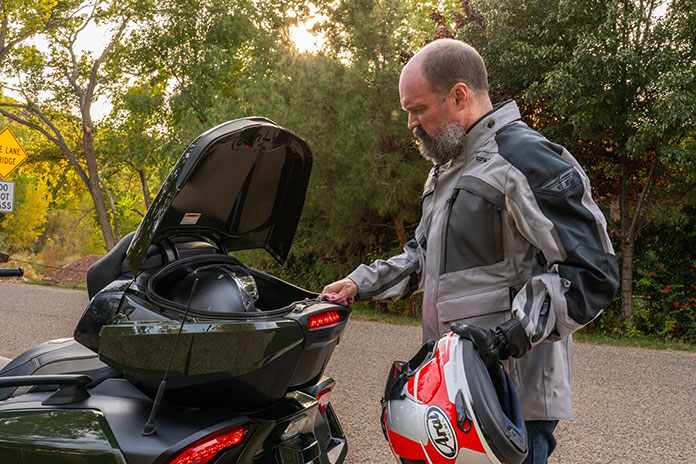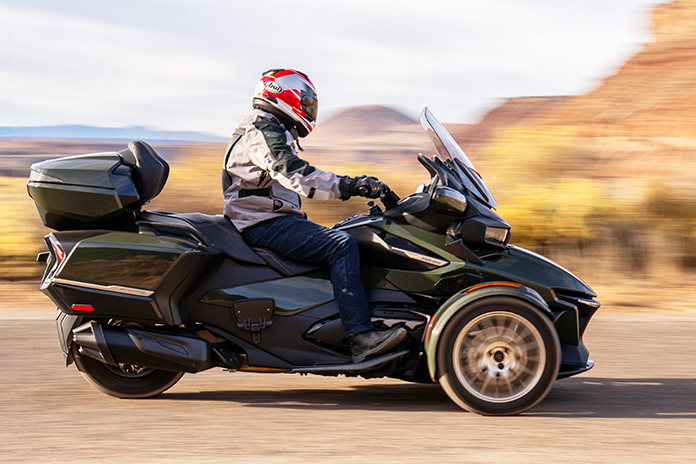
I haven’t been on a vehicle with three wheels since I was a kid tearing around my family’s back patio on my Big Wheel. And I’ve never been on one powered by something other than my legs, so I was definitely curious about the experience of riding a 2023 Can-Am Spyder RT Sea-to-Sky.
If I were a betting man, I’d guess BRP, Can-Am’s parent company, gets tired of hearing, “It’s not a motorcycle.” Well, after 1,100-plus miles on the top-of-the-line touring model, which included about 900 miles roundtrip from Southern California to the high desert of southern Utah and back, as well as taking it for a spin with several passengers, including my 11-year-old son, my “gradually coming around to anything less than four wheels” wife, and my 77-year-old father with Parkinson’s, I believe the Spyder defies a lot of categories.
Down by the Seaside | Can-Am Spyder RT
Before taking the Sea-To-Sky home from Torrance, California, I rode it to meet up with Kevin Duke, the EIC of our sibling publication American Rider, in Seal Beach for dinner. This is where the STS felt right at home: by the sea. I could envision myself regularly hopping on and cruising around any number of beach communities with some tunes cranking from the very capable six-speaker BRP Audio Premium sound system. Whether going up the coast or just to the market, the 47 gallons (178 liters) of storage is ample for whatever you need to carry along. And if not, it’s calibrated to pull a Can-Am trailer.
After dinner, I hopped back on the freeway for a nighttime ride to my hotel. That’s when I discovered that only certain switches are backlit. The turn indicator switch is not one of them. Nor is the horn. As a result, I inadvertently honked at a few people when I was trying to let them know I was changing lanes. And while the signals are self-canceling, the switch is difficult to turn off when changing lanes, often just turning on the other signal.
With rush-hour traffic cleared, I got my first taste of what the STS could do with a little breathing room. All Spyder RT models are powered by a liquid-cooled, 1,330cc Rotax ACE (Advanced Combustion Efficiency) inline-Triple making a claimed 115 hp at 7,250 rpm and 96 lb-ft at 5,000 rpm. Given its 1,021-lb dry weight, the power-to-weight ratio is fairly low. With a smooth throttle-by-wire, it doesn’t have any problem launching off the line, but if you need to quickly overtake at higher speeds, you’ll need to drop it down a gear or two. I would’ve welcomed a ride mode besides just standard or Eco that offered quicker power delivery.
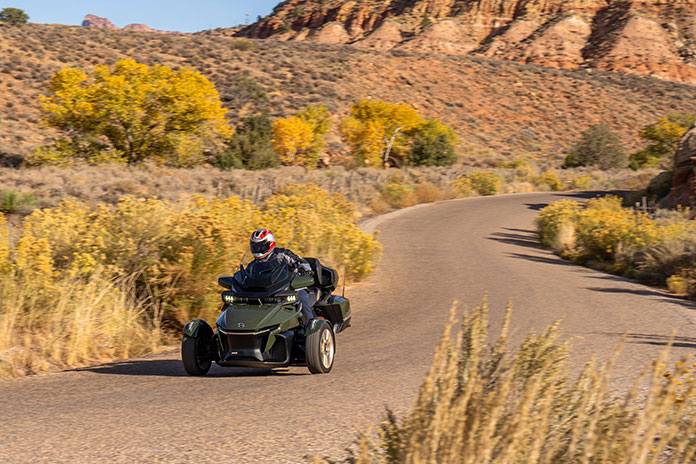
Related: 2024 Can-Am Spyder F3 and RT Review | First Look
Speaking of quick shifts, the RTs have a 6-speed semi-automatic transmission with shifting handled manually with thumb and index-finger paddles on the left grip. However, the left grip felt a little small for this arrangement. I don’t have big hands, but the space felt a little tight, especially with bulkier heated gloves, and I worried that I would accidentally trigger one of the paddles. The RTs will downshift automatically, but I had a couple issues with this, including responsiveness. When I would coast to slow from 6th, unless I applied the brakes, I could get down to around 1,800 rpm before it downshifted, which meant that if I needed to accelerate again in a hurry, I’d either be trying to do it in a too-high gear or have to quickly downshift manually. Also, when I was cruising around town (where the automatic downshifter works better), I sometimes forgot I had to manually upshift.
However, the inline-Triple holds its own at speed, and for my early introduction to a Can-Am Spyder RT, it was a blast bombing down the California freeways and through the evening mist caught in the yellow halogen cones of light while Led Zeppelin wailed from the speakers. I was definitely grinning, so maybe the people I honked at thought it was out of exuberance.
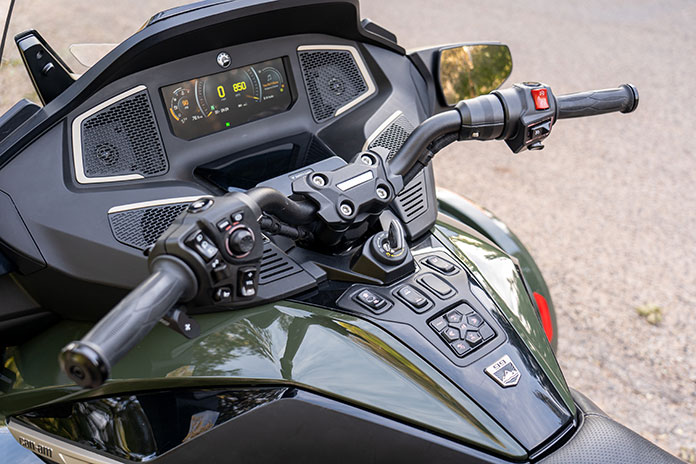
Spirit in the Sky | Can-Am Spyder RT
The next morning, I started the 450-mile journey from sea level to my home at 6,000 feet, providing an idea of how this luxury tourer handles long hours in the saddle. However, I pushed it a little more than just a casual tour – strictly for research purposes, of course.
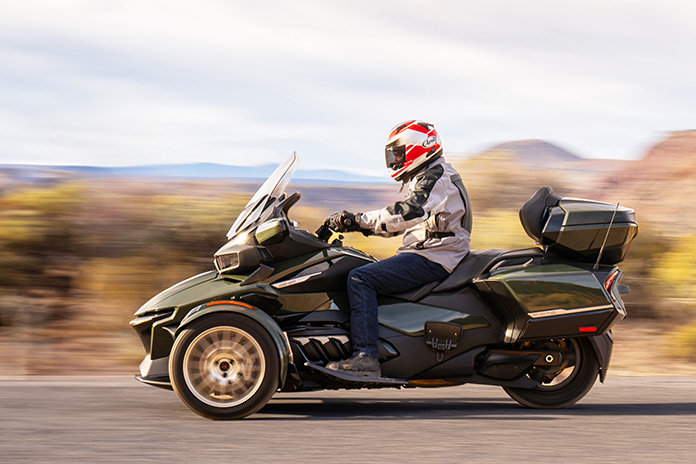
GEAR UP
- Helmet: Arai Quantum-X
- Jacket: Fly Racing Off Grid
- Gloves: Highway 21 Hook Glove
- Pants: ScorpionEXO Covert Ultra Jeans
- Boots: Joe Rocket Sonic X
The first thing I noticed was how three wheels affects the suspension experience. The RT Sea-to-Sky has Sachs suspension components, nonadjustable in the front with 6.9 inches of travel and with manual air preload adjustment in the rear with 6.0 inches of travel. On two wheels, you only dip or rebound, but each side of the RT’s front suspension system works independently of the other, which creates a different plane of movement than two wheels. For example, if the road conditions are different on one side of the lane or you ride over a change in road surface at an angle, there is not just the front/back suspension travel but also a side-to-side change, which takes some getting used to. However, on a consistent road surface, I was able to get the Spyder just south of triple digits on a couple straightaways, and it was surprisingly smooth.
Cornering is probably the biggest difference in the ride. The owner’s manual is very clear on this point: “Do not countersteer as you do with a motorcycle. Unlike a motorcycle, this 3-wheel vehicle cannot lean while turning. You must relearn how to turn. … You will feel sideways forces pushing you to the outside of the turn. … In tight turns, it may help to lean your upper body forward and toward the inside of the turn.”
I couldn’t have said it much better. When cornering on a motorcycle, the rider and vehicle lean together. When cornering on a Spyder, the vehicle pivots and the rider leans to compensate for centrifugal forces. I went into several corners pretty hot, and it took some muscling to hold my line. All Can-Am Spyders are equipped with a Bosch-engineered Vehicle Stability System (VSS), which integrates ABS, electronic brake-force distribution, traction control, and stability control, along with Dynamic Power Steering. Being new to the three-wheeled experience, I had to calm my nerves a bit until I got more comfortable with the dynamics. Only having a foot brake – albeit a substantially sized pedal – also required some adaptation.
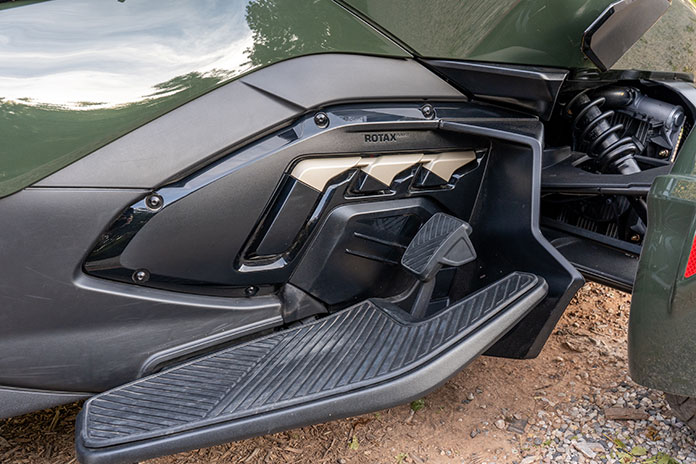
If you’re not in a hurry, these things won’t be as much of an issue. But if you’re wanting to push it a little more, it’s an engaging experience, in some ways more immersive and intense than riding a motorcycle. To maneuver at speed, I had to pay attention and work a little more.
Given these experiences – which reminded me of riding ATVs in my younger, wilder years – even though people talk about how great Can-Ams are for those who don’t want – or are unable – to wrangle a bigger touring bike anymore, the RT is also a good match for those who are looking to transition out of the four-wheeler world into something they can pack up and take on the road while enjoying an open-air, full-body experience.
However, when you do take it on a roadtrip, don’t expect stellar mileage. On my trip from California to Utah, I averaged 28.7 mpg. With a 7-gallon tank, this adds up to just over 200 miles of range. But with a roomy and plush seat, wide and long footboards, an electrically adjustable windscreen, and adjustable side wind deflectors, it’s easy to do these miles in one sitting. Keep an eye on that range, though, as the countdown of remaining miles to fill-up disappears when you drop below 20 miles.
You may also lose a little oomph in mountain passes. On the Black Ridge just south of my home, the interstate climbs about 2,000 feet over the span of a dozen miles, and when I hit a 15-mph headwind coming up the ridge, the RT couldn’t hold its speed. However, thanks to the three wheels, I never had any clench moments when I got blasted by crosswinds over the span of nearly 500 miles.
Related: 2023 Can-Am Ryker Rally Review | Road Test
It’s a Family Affair
With all those solo touring miles, once I returned home, I was excited to take the Spyder out with some pretty tough critics riding pillion.
My 11-year-old son, who has ridden with me on most test bikes I’ve reviewed, said he loved it more than any of the others. In the October 2023 Exhaust Note, I talked about how he gets a little nervous leaning over on curvy roads, so I think he liked the stability on the Spyder. I also talked about his “flying” arms when we’re on straightaways. I caught a glimpse of those spread arms in the mirrors of the Can-Am, as well as hearing shouts of jubilation as we cruised the rural valley outside of town blasting Imagine Dragons, one of his favorite bands. (Did I mention that the sound system is one of the best I’ve heard?)
My wife and I are on mostly common ground when it comes to music, and I often put our mellow Ray LaMontagne library on shuffle when we’re on two-wheel tourers, but the Can-Am felt better suited to the rowdier Nathaniel Rateliff. This is maybe why I ended up pushing it a little more when she was on the back. She had a similar difficulty getting used to the sensations of the three-wheeled suspension and cornering at higher speeds. However, she liked the wide seat and backrest and thought the grips were better situated than some other bikes, which were more of a reach for her and ended up causing back discomfort.
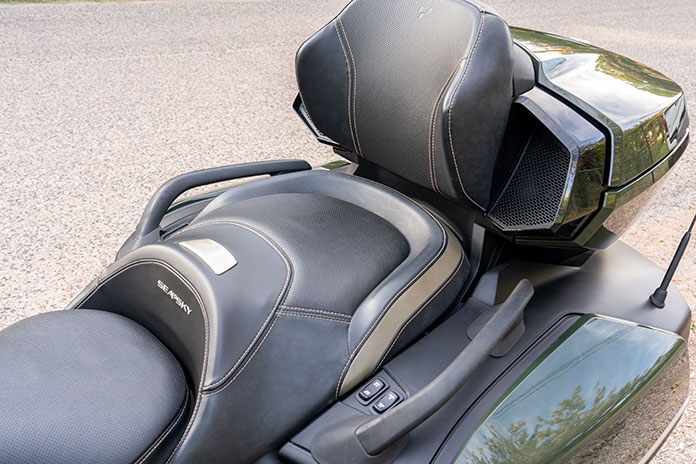
My dad is an outlaw country guy. I’m also a Waylon, Willie, and Johnny fan, so I could’ve played that when we went for a ride, but I wanted him to experience the pure ride for what it was: his first time climbing aboard something with less than four wheels (or hooves) in decades, a moment especially poignant given his Parkinson’s diagnosis. We clunked helmets a few times, but about 20 minutes in, when I thought he might be getting tired, he gave me the thumbs up, and we kept going.
I had prepped him with a few things to think about during the ride, and when we got back, I could tell he really enjoyed it, and I asked him to put together a couple paragraphs about his experience. He sent me about 2,300 words. And to think I used to get in trouble for not following directions.
Because he has a way with words and makes some interesting observations about the nature of being a motorcycle journalist, I have included the (mostly) unabridged version after the spec chart below, but to summarize based on his “essay” and my conversation with him, riding the Spyder was a good experience. As with my wife, he appreciated the comfort of the ride, the generous room for a passenger, the cushy seat, large passenger footboards, and foam hand grips.
“If my Can-Am ride antedated our (recent) final decision on new dining room chairs,” he wrote, “so comfortable was the seat on the Can-Am that there would now be four of them, each one parked on the four sides of our dining room table.”
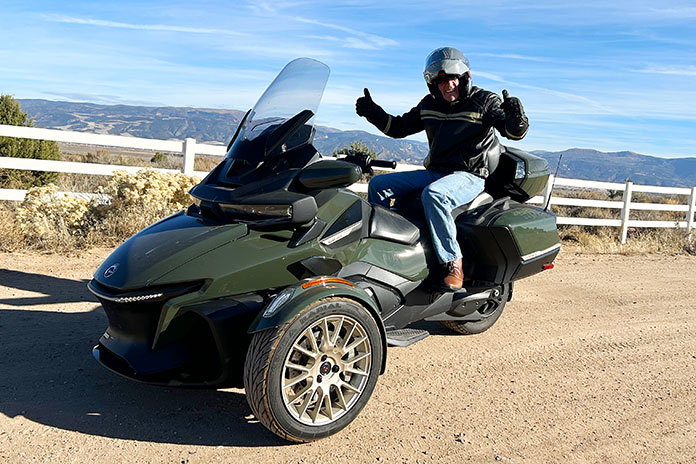
He also agreed with how smooth the ride was at speed, with no helmet buffeting – or anxiety – as we got up near 80 mph. Most important to him, however, was the sense of stability. Many injuries suffered by people with Parkinson’s are the result of falling, which starts with a lack of balance.
“When we start to take a fall, we do not react appropriately. … The positioning of the handgrips and the legs of an individual riding pillion on the Can-Am, combined with the lack of leaning required from a passenger, contraindicate getting into a fall trajectory posture.”
I was just glad he had fun.
In “Everyday People,” Sly and the Family Stone sings about “different strokes for different folks.” The 2023 Can-Am Spyder RT Sea-To-Sky may be the perfect vehicle for those looking to transition from two wheels to something easier to handle or from a four-wheeler to something that opens up a new world of possibilities. Or just someone looking for a new experience.
It’s a hard vehicle to define, but once you get over the fact that it’s not exactly what you’re used to, you can learn to enjoy it on its own terms. It gave me a chance to do something with my father that I may not ever get to do again, and for that, I will always be grateful.
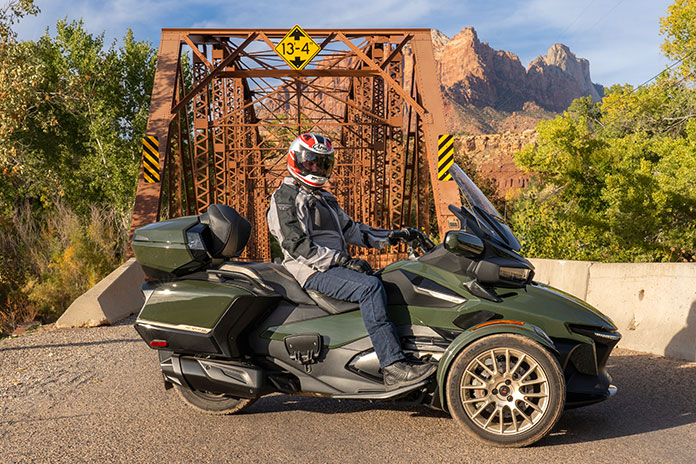
2023 Can-Am Spyder RT Sea-To-Sky Specs
- Base Price: $32,999
- Website: Can-Am.BRP.com
- Warranty: 2 yrs., unltd. miles w/ roadside assistance
- Engine Type: Liquid-cooled, transverse in-line Triple, DOHC w/ 4 valves per cyl.
- Displacement: 1,330cc
- Bore x Stroke: 84.0 x 80.0mm
- Horsepower: 115 hp @ 7,250 rpm (claimed)
- Torque: 96 lb-ft @ 5,000 rpm (claimed)
- Transmission: 6-speed, semi-automatic w/ reverse
- Final Drive: Belt
- Wheelbase: 67.5 in.
- Rake/Trail: n/a
- Seat Height: 29.7 in.
- Dry Weight: 1,021 lb
- Fuel Capacity: 7 gal.
- Fuel Consumption: 28.1 mph
- Estimated Range: 197 miles
See all of Rider‘s Can-Am coverage here.
Thoughts on the Can-Am Spyder RT Sea-to-Sky and other topics by Daniel R. Dail:
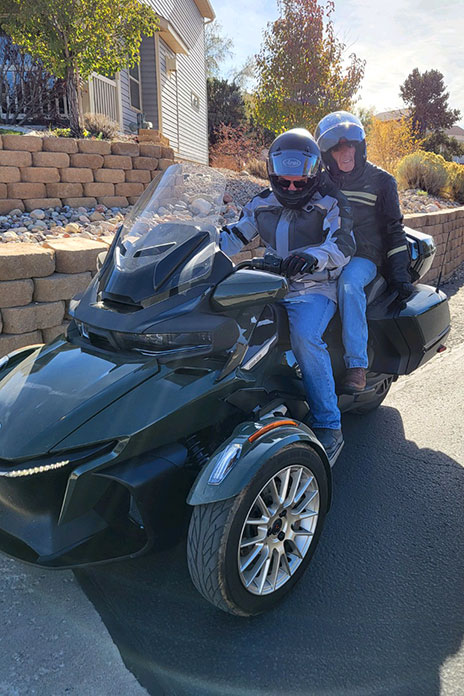
My son Paul tests and reviews motorcycles for a living for two upscale magazines. I am moved to wonder how many men envy him in this, one of the more unusual, if not bizarre, mixtures of the arts and sciences that one can conjure up.
In thinking about it, it may not be as strange as it seemed at first glance. Someone has to do it. I never gave it much thought until now, but machines can have a legacy that’s truly their own. Think not? Think again. The Ford Mustang. The 1932 Ford Coupe. The Harley Davidson 1948 Panhead, 1964 Chevy Camaro, 1964 Ford Edsel, and hundreds, perhaps thousands more. In each case, someone has to tell its story, set in motion those things that would become part of what that machine represents. Even in the case of classic failure (Edsel), someone has to start the record.
Welcome to the intersection, the place where the impossible happens, the lamb lays down with the lion, a place where the sword ever so gently embraces the pen, and the covenant they share creates the story of a particular machine through the gauntlet, through fire and ice. That story may very well turn out to be that machine’s legacy. A motorcycle journalist position requires excellent judgment, a solid business acumen, and astute instincts for diplomacy when writing up the assessment report on a particular make or model of motorcycle.
There are spectacular true accounts, especially in automotive history, whereupon the future of an entire company, its stakeholders, and employees were riding on the acceptance of a new model or concept, only to be driven askew by a negative review. Occasionally, a sword can be withdrawn in time to stem the hemorrhaging; rarely, if ever, can this happen with the pen.
I can give no assurances that Paul himself is fully cognizant of the enormous power he wields in carrying out of his duties in what his older brother has labeled a dream job. Whether a novelist or essayist, while holding a reader’s interest is important, holding their trust is the Holy Grail. History is replete with accounts of multitudes of humanity who have given over the gift of their trust to a charismatic leader only to be richly rewarded; others have paid the ultimate price for the misplacement of their gift of trust. They didn’t drink poison from the cup because they were thirsty; they drank it because they trusted the person serving it to them. I am of the opinion that trust has been undervalued – not given its due.
Paul’s typical first ride on a particular motorcycle to which he has been assigned originates in traffic-choked Los Angeles County, population density over 2,400 people per square mile and 89 feet in elevation, and it draws to a conclusion about 450 miles away in Iron County, Utah, density 15 people per square mile and elevation just under 6,000 feet.
Much of the ride is on the high desert (aka cold desert) biome of the Mojave, a moody, ever-changing landscape with a beauty all its own that can suddenly be interrupted by a hostile paint-stripping sandstorm or a 30-degree temperature plummet that can only be a prelude to a marble-sized summer hailstorm. Then there’s the much feared and much maligned gully washer. Torrents of water seemingly appearing out of nowhere, laying to waste everything in its path.
Much of this rather fragile land has not taken kindly to the scars carved into its surface by marauding throngs of dirtbikes, dynamite blasts which would become manmade gorges, and incessant assaults from a developer’s bulldozer. They tear out the sage and uproot the juniper trees and then name the streets after them.
There is a rich history of native people inhabiting parts of Mojave, but for the most part it is rather hostile to human habitation. There, a lone motorcyclist has to develop good instincts for changing conditions.
Compared to Paul, I am an imposter, a poor replica of the real thing. But here I am, neither a writer nor motorcycle afficionado, preparing for a small taste of what my son does professionally. But I am a creature of my own design. I am what I call a “word stylist,” an inferior subspecies of writer who writes from a place of raw emotion and who has but a fleeting acknowledgement of the rules of punctuation and sentence structure.
I am schooled in the sciences, so it doesn’t make sense that I am so attracted to “paragraphical” sentences and the use of ten words when five will do nicely. I like to push the limits of language. I think that there is a certain elegance in the use – but not overuse – of archaic words and phrases. Elaboration knows no better friend than I.
So how do I earn the reader’s trust? The first thing that I must do is remember is to stay in my own lane, figuratively speaking. I have been invited to be a guest on board the Can-Am Spyder RT Sea-To-Sky (hereafter, the “Can-Am”). Nothing more. I will not handle any controls, bells, or whistles unrelated to my role as an uninformed passenger with a paucity of technical acumen aboard a behemoth of a machine that bears no resemblance to the arachnid for which it is named. Looking down from aloft, there is an unmistakable likeness to a scorpion, however. Somebody really missed the mark naming this machine. And “Sea to Sky”? Out of fairness, there is no ocean front nearby to Cedar City, but the whole time I was on board the Can-Am, not once did it leave solid ground to become airborne.
After I have become thoroughly saturated by the experience aboard the Can-Am, like Paul, I will be asked to write about it, but unlike Paul, my testimony will be stripped of technical jargon or inference made from previous experiences because I haven’t had any, unless you count a Cushman Highlander and a Triumph 250cc bike in the early 1960s.
My contribution will be largely sensory: What does it feel like? So it would seem that my value to this story is that I don’t know very much, and if I can own up to it (stay in my lane) and not try to convince the readers otherwise, I will have served my purpose.
Particularly pertinent to this venture into the unknown are my age – I am 77 – and that I have a neurodegenerative disorder, Parkinson’s disease. This makes me susceptible to a myriad of symptoms that, without some accommodation, might make the ride on the Can-Am something less than a good idea.
Seventy-seven years requires little in the way of an explanation. I didn’t do anything wrong, and I didn’t do it on purpose; it just turned out that way on my last birthday.
Parkinson’s disease is another set of circumstances and plays heavily into what I can say about the view perched in the “not aloft” of the passenger seat of the Can-Am (there is no awkward towering over the driver).
Were I asked to give a one-word description of the Can-Am, it would be “generous.” There is more than ample room for driver or passenger to mount first, assisted by the three points of contact with the ground. For someone with Parkinson’s, this could be the difference between going or having to stay home.
On this particular day, I sauntered up, stepped on the main footboard with a confidence bolstered by the size of it, hoisted my right leg over the seat back, and eased slowly down the backrest gently kneading my lower back, waist, and rib cage as I settled down onto the seat with its rather complex combination of tucks, rolls, and rises. The seat pad yielded in places, and I redirected my legs to the large, stirrup-like 4×6-inch passenger footboards and tested the soft, ample 12-inch foam handgrips.
This may be as good a place as any to mention that my wife and I had been searching for some new dining room chairs about the same time as I took my ride on the Can-Am. For the dining room chairs, comfort needed to be the most important feature. We longed for those seemingly irretrievable days when family and good friends could sit around the dining room table for hours after a meal and just talk. Everything from Russia’s war in Ukraine to the possibility of a particular horse winning the Triple Crown might be discussed. No TV, and cellphones turned off. Just good conversation with people you care about.
We finally found chairs that looked like they would serve our needs nicely on Amazon, but if my Can-Am ride antedated our final decision on new dining room chairs, so comfortable was the seat on the Can-Am that there would now be four of them, each one parked on the four sides of our dining room table.
The basic platform of all Can-Am cycles is the same three-wheeled configuration of two up front and one behind. My assignment is very specific on this point. I’m bound to the notion of being someone who knows very little – or nothing – about the technical specifications of this machine and therefore have nothing of substance to say about this configuration without running the risk of not staying in my own lane as I promised I would do. I will leave the merits and drawbacks to others. I am confident, however, in saying the Can-Am gives an amazing sense of stability because of its three-wheel configuration.
Those of us with Parkinson’s disease don’t do well in crowded places, so riding pillion on a 4-inch-wide seat pushed up over the back of the driver would not be my idea of an ideal cycling experience. Neither would the reciprocal – nothing to give stability, or a sense of reckoning with the natural forces in the world within which we exist. Take gravity, for example. Taking any statistic on falling and adding Parkinson’s disease and adjusting for age, and it is worse.
Everything about falls, including occurrence, injury, hospitalizations, and deaths due to falls is worse with Parkison’s. Over time, the disease erodes one’s ability to react, reaching a point where, when we start to take a fall, we do not react appropriately. An example of appropriate reaction would be to raise your arms to cover your head or your face to lessen the damage done on impact or put your hands out in front of you to lessen the impact itself, to “break the fall.”
Falling is a surprisingly complicated action involving a large number of soft tissues and organs laid upon or protected by a rigid framework and a nervous system firing at blinding speed in an effort mitigate the damage. However, there is little in the way of mid-fall recovery when someone has Parkinson’s. Once you are in a fall trajectory, you are most likely to be consumed by a kind of helplessness so overwhelming that it is somewhat akin to being pulled into the fall. The trajectory is like a vacuum tube: You are literally sucked into it.
I have no first-hand experience to draw upon since my Parkinson’s diagnosis, so I must speculate that the leaning that is part of negotiating turns on a two-wheel motorcycle would not bode well with the balance problems of the kind that often accompany Parkinson’s. Leaning is also one of the ways we end up in a fall trajectory.
However, the positioning of the handgrips and the legs of an individual riding pillion on the Can-Am, combined with the lack of leaning required from a passenger, contraindicate getting into a fall trajectory posture. Additionally, the adjustable windscreen cuts a wide swath, leaving both passenger and driver well-protected from windblast, even at speeds in excess of 75 mph, which gave me an added sense of security.
So now we come to the elephant in the room. What is someone with Parkinson’s disease doing on a motor-driven cycle anyway? Well, PD is progressive disease: In early stage, it may not even be noticeable; at end stage, you’re more worried about where your next breath is coming from than going on a motorcycle ride (suffocation is responsible for a lot of deaths in people with PD). It’s what comes between early and end stage that really matters. And isn’t that pretty much the way it is for everyone, PD or not? Michael J. Fox made a couple of movies and filmed several episodes of the TV show Spin City in early-stage PD. Who knew? Now in the middle stages of PD, the disabling effects are considerably more evident. Perhaps he might have second thoughts about jumping on a Can-Am and taking an afternoon ride. Me? I wouldn’t give it a moment’s hesitation – at least not today. Just watch me.
This machine, the Can-Am Spyder RT Sea-To-Sky literally shouts the words “Riding Two Up,” given its generous dimensions, stability, and passenger accommodations aplenty.
Fifteen years after my diagnosis. I awaken almost every morning knowing that as soon as I wipe the sleep from my eyes, the fight for who will rule this day will already be under way. It’s going to be one helluva battle, and I am going to be right in the thick of it. My opponent is Parkinson’s disease. Some days I do pretty well – other days, not so much. But every day, every single day that I show up, PD will know it has been in a fight.
That is how I have earned Parkinson’s creds. It’s the same way Paul has earned motorcycle and writing creds…it’s the hard way. And because I have stayed in my own lane, shown the readers that I trust them, and because Paul Dail is my son, it has hopefully earned me at least a glimpse of the coveted treasure, the Holy Grail: the reader’s trust.
The post 2023 Can-Am Spyder RT Sea-To-Sky Review | Ridden and Rated appeared first on Rider Magazine.
Source: RiderMagazine.com

